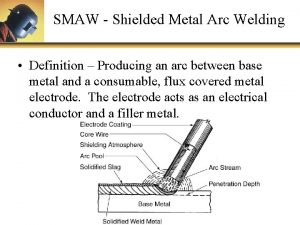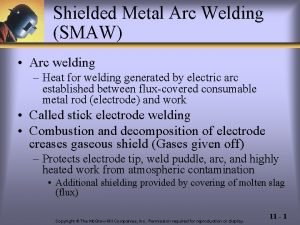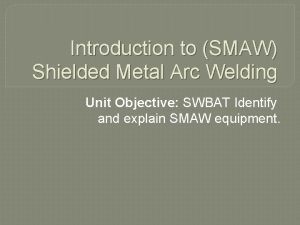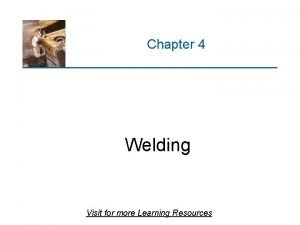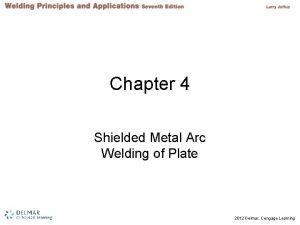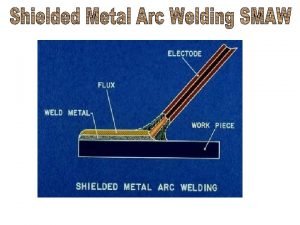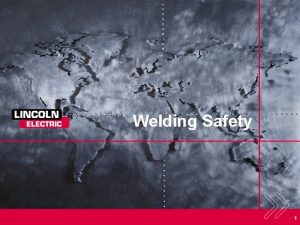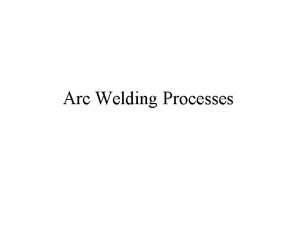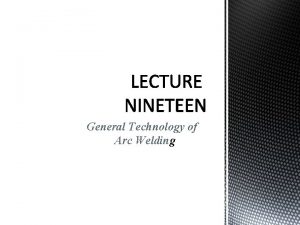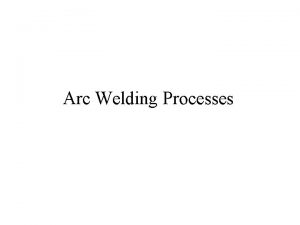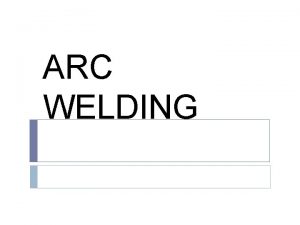Arc Welding Welding is one of the most














- Slides: 14

Arc Welding

Welding is one of the most dangerous professions. Flying sparks … toxic fumes … volatile gases … high electrical currents … and radiant heat are just a few hazards of this craft. Then there’s the danger to your eyes, such as developing cataracts.

What is Arc Welding? • Arc welding uses a welding power supply to create an electric arc between either an electrode or stick and the base material to melt the metals at the welding point.

Hazards ULTRAVIOLET RADIATION – Welding produces the entire spectrum of Ultraviolet Radiation (UV A, B & C) – If skin exposed for too long, welder can get a ‘sunburn’ – Can cause skin malignancy (aka skin cancer) – Ocular Melanoma – Arc Flash can occur through the side of the eye

Hazards RADIANT HEAT • • Welding Guns can produce heat above 1, 000 Degrees Can burn skin and eyes Welders wear PPE including gloves, long sleeves (usually made out of leather or another thick material) and a welding hood. In Florida, and other hot climates, the welding PPE itself can cause OVERHEATING.

Precautions (Personal Protective Equipment) • Select the correct filter lens suited for the process you are using and that provides you with the best eye comfort and safety. .

Hazards GASES • During the welding process there are several fumes and gases released as the filler material and metals bond with each other. • Welding should always take place in a well ventilated area to allow the toxic fumes and gases to escape. Gases, such as argon, displace oxygen, causing death. • Some workers are exposed to excess Manganese fumes which can cause Manganism and Parkinson’s Disease.

Precautions • • • VENTILATE the Area. Use low-fume welding rods when possible Use local-exhaust ventilation and keep exhaust hood openings 4 to 6 inches from the fume source Use air blowers to blow fumes away from you Keep your face as far away from the welding plume as possible Use a respirator when possible especially when ventilation is inadequate

Hazards ELECTRIC SHOCK • Welding processes that use electricity pose both obvious and subtle hazards of electric shock – which can be fatal.

Precautions • • Wear dry, insulated gloves in good condition and protective clothing. (Change as necessary to keep dry) Insulate yourself from the workpiece and ground by wearing rubber soled shoes or stand on a dry insulated mat. Do not touch the ground with any other part of your body. Do not wrap cables carrying current around your body. Do not touch an energized electrode with bare hands. Turn off all equipment when not in use. Use only well maintained equipment and cables Avoid Wet working conditions, even perspiration can lower the body’s resistance to shock.

Hazards Explosions/Fire Although it is less heard of, since there are sparks formed by the welding method explosions and fires are a risk welders work with.

Precautions • • Do not weld on containers that have held combustible materials. Check carefully before welding. Remove flammable materials from welding area or shield from sparks heat. Keep a fire extinguisher in the immediate area. Wear fire retardant clothing and safety cap. Use earplugs for overhead welding.

How Dangerous is it Really? • More than 365, 000 welding related eye-injuries YEARLY. • Even people who are not welders can be injured from being too close to the arc. • Few Explosion Related Deaths but there are still cases. • More than 10, 000 people per year are seriously injured as a result of a welding accident.

OSHA Says (1926. 351) • • Use only manual electrode holders specifically designed for arc welding/cutting. Any current-carrying parts must be fully insulated. Cables/Equipment in need of repair shouldn’t be used. Proper Grounding required. Unattended electrode holders shall be placed so that they don’t come in contact with employees or conducting objects. Hot electrode holders shouldn’t be dipped in water (risk of electric shock). Power Supply should be turned off when not in use. Whenever plausible, all operations shall be shielded by noncombustible or flameproof screens which will protect employees and other persons working in the vicinity from the direct rays of the arc.
 Arc promoteur vs arc investigateur
Arc promoteur vs arc investigateur Minor segment of a circle
Minor segment of a circle Minor arc
Minor arc Arc emu88 com arc info 37 100037 html
Arc emu88 com arc info 37 100037 html Smaw meaning
Smaw meaning Welding arc length
Welding arc length Smaw unit
Smaw unit Arc welding introduction
Arc welding introduction Tig (tungsten inert gas)
Tig (tungsten inert gas) Weaving welding definition
Weaving welding definition Chapter 3 shielded metal arc welding
Chapter 3 shielded metal arc welding Fcaw
Fcaw Arc welding ppe
Arc welding ppe What is scratching method in welding
What is scratching method in welding Metal arc welding
Metal arc welding




